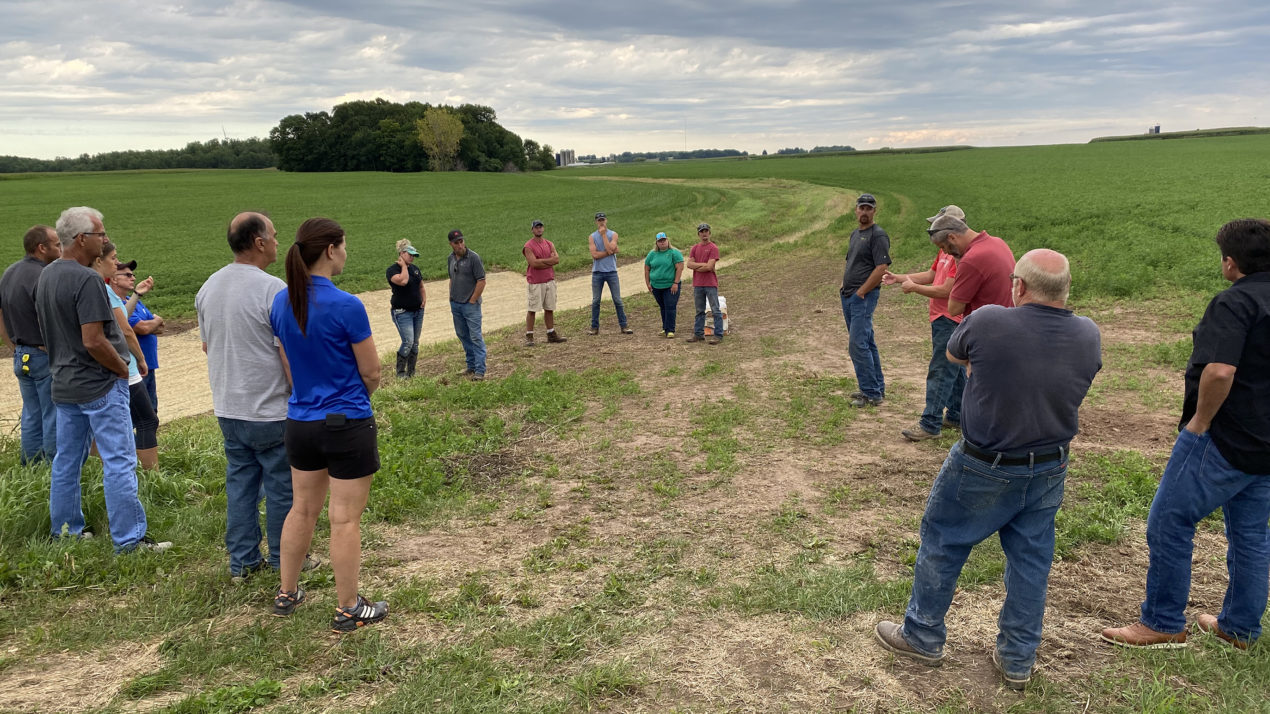
Nurturing soil health has been an integral part of Peninsula Pride Farms’ innovative work to improve water quality in northeastern Wisconsin. A new analysis confirms that those efforts are making a difference.
Field practices adopted by the farmer-led watershed conservation group’s livestock and crop farmers are significantly reducing the chance of harmful runoff into streams and lakes, according to research shared by the state Department of Agriculture, Trade and Consumer Protection, the University of Wisconsin-Madison, and The Nature Conservancy.
Using data about farming practices among members of Peninsula Pride Farms (PPF), the analysis calculated an estimate of the potential impact of various practices compared to more conventional methods on typical crop and livestock operations in Kewaunee and southern Door counties. The findings show, for example, that the farmers using strip-tillage and no-tillage potentially reduce phosphorus runoff from farm fields by 50 percent and soil erosion by 60 percent.
Stopping phosphorus and soil sediment from leaving farm fields improves water quality. For example, every pound of phosphorus that reaches a stream or lake can potentially feed 500 pounds of algae, degrading the waterway.
“Peninsula Pride Farms members are excited to see the impact of their conservation work over the past several years,” Don Niles, a dairy farmer who leads PPF, said. “We are proud that as an organization we have grown to the point where we can tally scientific results. While there is ongoing work to be done, it is gratifying to see how far we have come in our efforts to protect our peninsula’s land and water resources.”
The five-year-old nonprofit group has grown to 43 farmer-members, who represent 63,038 acres and 67,276 dairy animals and beef cattle. The group collaborates with university researchers, environmental groups and community leaders, and they hold field days to demonstrate various practices.
“Since their inception in 2016, the Peninsula Pride farmers have made huge strides in getting cover crops planted and using reduced tillage and low-disturbance manure injection,” said Steve Richter, agricultural strategies director at The Nature Conservancy, which is a key supporter of the farmer group and helped fund the analysis.
“PPF members are very open to making changes to their operations to benefit soil health and reduce environmental impacts, which is why they are one of the biggest drivers of farm conservation in northeastern Wisconsin,” he said.
PPF members are regularly practicing other conservation techniques as well, such as soil sampling, split nitrogen application, nitrogen stabilization and planting grass waterways. They are also figuring out how to make these practices financially sustainable through increased productivity.
CONSERVATION PRACTICES
PPF farmers have made noticeable changes to their practices. The most recent numbers (2019):
- 18,697 acres of conservation tillage practices (either strip-till or no-till planting)
- 63,038 acres covered by nutrient management plans
- 10,124 acres of cover crops
- 6,089 acres of low-disturbance manure injection
MORE ABOUT THE ANALYSIS
The analysis was completed as part of a conservation benefits tracking project initiated by the Wisconsin Department of Agriculture, Trade and Consumer Protection to evaluate impacts of the state’s Producer-Led Watershed Protection Grants Program. The initiative was developed in collaboration with the University of Wisconsin-Madison Department of Soil Science and The Nature Conservancy. Wisconsin’s SnapPlus nutrient management planning software was used to calculate the potential annual phosphorus loss and soil erosion on fields when farms include practices such as cover crops and reduced tillage.
While not every conservation practice provided significant reductions for each scenario, below are examples of the amount of phosphorus loss and soil erosion that can be avoided with the adoption of practices on agricultural landscapes in southern Door and Kewaunee counties. Acreages of practices are based on the average number of acres implemented on PPF member farms in 2019.
It is important to note that the calculations below are based on comparisons of generalized systems, not actual farms, and do not take into account the other watershed variables that impact how sediment and phosphorus make their way into a stream or lake.
For comparison, a mid-size dump truck can carry 10 tons of sediment, and 1 pound of phosphorus in a waterway has the potential to cause the growth of up to 500 pounds of algae.
Dairy farm with a corn silage and alfalfa rotation adopting 362 acres of small grain cover crops following corn silage
Phosphorus loss reduction: 420 pounds
Soil erosion reduction: 326 tons
Corn, soybean and winter wheat operation adopting 708 acres of strip-tillage
Phosphorus loss reduction: 1,083 pounds
Soil erosion reduction: 885 tons
Continuous corn operation adopting 327 acres of no-tillage
Phosphorus loss reduction: 1,347 pounds
Soil erosion reduction: 958 tons

